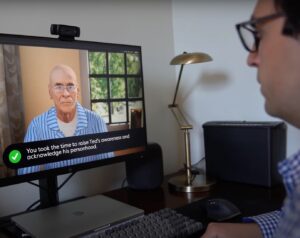Over 400,000 Australians living with a diagnosis of dementia, one in three people aged over 85 is now living with some form of dementia or cognitive impairment – and these figures are set to grow, even as the aged care sector continues to see significant workforce shortages.
The reality is that residential care and home care staff cannot provide the ‘touch’ and companionship that older people need 24/7 – but technology can help to bridge this gap.
New innovations are assisting to provide social connection and wellbeing – and enabling aged care staff to improve their care and communication with people living with dementia.
AI companion designed to calm and soothe
The latest to make its debut is Viv – an artificially intelligent (AI) character who shares a number of symptoms and experiences associated with dementia.
Based on four women with similar symptoms of vascular dementia, Viv is one of a suite of digital characters being developed by the felt Experience & Empathy Lab (fEEL) at UNSW Sydney to provide companionship for people living with dementia.
“The characters don’t just provide companionship, they can also help with co-regulating emotion, as would happen with a human companion,” said ARC Laureate Scientia Professor Jill Bennett, who leads the lab.
“This is very helpful when people living with dementia experience confusion or hallucinations. One potential positive effect we envisage is in terms of offering a calming and soothing response when people are anxious or distressed.”
Viv is now being taken into a number of aged care facilities – both on a life-sized portrait screen and on iPads – to research how the technology can be used to support residents living with dementia.
Personalised platform sees 70% reduction in resident incidents
Another therapeutic technology that is seeing significant improvements in behaviours in people living with dementia is Resparke, formerly known as Moove and Groove.

Established in 2019, its platform contains thousands of music playlists, videos, and podcasts for older people with an AI-supported resident matching system that records a residents’ interests, preferences, and life story.
“What we have learned about dementia is that in order to be able to change a behavior, you have to find something that is meaningful to that person,” Resparke founder and CEO Alison Harrington said.

“For example, when a care staff member comes in, they can look that resident up on the platform, click on their name, go to their page and already have 20 different items which are personalised to that person to instantly play.”
This personalised approach is delivering real results for the service, which has expanded to 280 aged care homes across Australia.
Resparke has just concluded a dementia care trial in memory support units where one site recorded a 70% reduction in incidents over a three-month period.
In one case, a resident who had previously required two or three staff to shower him was discovered to be a fan of Slim Dusty. Playing his music reduced these incidents and staff were able to shower him.
Communication key to connecting with people living with dementia
AI is also helping aged care staff and providers to communicate respectfully with people living with dementia
The national peak body Dementia Australia has developed its own AI-based platform ‘Talk with Ted’, which is a realistic online simulation that sees users guide ‘Ted’ through the showering process.

“Whether it’s in home care or residential, it doesn’t matter what stage of the disease; the advice is always the same which is good communication,” said Dr Tanya Petrovich, Manager of Innovation at Dementia Australia.
Tanya uses the example of staff entering the room of an aged care resident and immediately going into the task of giving the resident their medication or assisting them to the toilet.

“Staff can forget that you need to engage the person because they will not recall why you are there or who you are. So, each time you meet them, you need to assume they have no knowledge of you and what is about to take place,” she stated.
The avatar is designed to allow staff to reflect on and adapt their current communication approach with clients and residents.
Help for families visiting loved ones in aged care
In addition, Dementia Australia offers a number of other free resources for aged care staff and families.
Its ‘Ask Annie’ app has a module on communication with advice on how to better communicate with people living with dementia.
The app has recently been updated to include a module on changed behaviours in people living with dementia, which is particularly aimed at home care staff.
The peak body also has an app aimed at improving communication for families visiting loved ones living in residential aged care.
Developed in collaboration by Melbourne aged care provider Lifeview Residential Care and Swinburne University of Technology’s Future Self and Design Living Lab, ‘A Better Visit’ features a range of two-player games designed to help family members to interact with a loved one, who may no longer recognise them.
If you need advice on supporting someone living with dementia, you can call the National Dementia Helpline on 1800 100 500 between 9am and 5pm, Monday to Friday (excluding public holidays).
If you are caring for a person living with dementia and need help accessing the right advice, services and support, you can also call Carer Gateway on 1800 422 737, Monday to Friday, 8am to 5pm local time.

